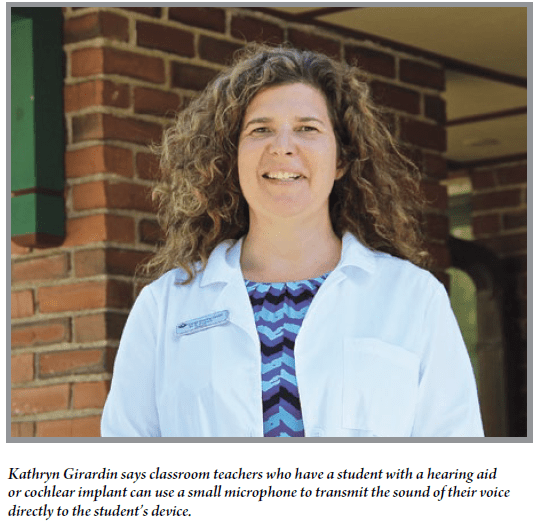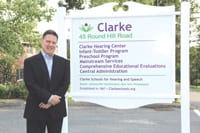Amplifying Potential – Clarke Schools for Hearing and Speech Set the Tone for positive Results
The brick building sits quietly on top of a hill in Northampton, and few signs point to its location or importance.
But the Clarke School for Hearing and Speech has been making a profound difference in children’s lives for more than a century, and every year more than 1,300 children from birth to age 15 and their families benefit from programs and services provided by the school’s flagship campus as well its locations in Boston, Jacksonville, New York City, and Philadelphia.
“Our goal has always been to help deaf and hard-of-hearing kids reach their full academic and social potential,” said Clarke President Bill Corwin. “It’s well within the range of possibility for children who are deaf or hard of hearing to develop spoken language skills that are as good or even better than their peers, and we are internationally recognized as a leader in regards to listening and spoken language programs for children.”
He added that although historically, people have associated sign language with deafness, today the majority of young people with a hearing loss use spoken language.
But when parents first learn that their baby is deaf or hard of hearing, they can feel overwhelmed.
“Every parent wants their child to have the same opportunities as other kids, and if there is no one in their family who is deaf or hard or hearing, they wonder what their life will be like,” said Corwin. “More than 90{06cf2b9696b159f874511d23dbc893eb1ac83014175ed30550cfff22781411e5} of deaf babies are born to hearing parents, and most have no real knowledge about hearing loss. There is denial and grief, and parents wonder how they can bond with their baby if they can’t communicate. But Clarke can help; our programs start when infants are 2 weeks old and we focus on the family to maximize the chances for success.”
This is knowledge he gained first hand; Corwin and his wife have two daughters with hearing loss, and they moved from California to Western Mass. to access the specialized help that Clarke is known for. “Our first daughter started here when she was less than a year old and they worked with us for an hour or two each week. By the time she was 3 years old she was ready to be mainstreamed, and when her sister was born and had a cochlear implant, the staff was with us every step of the way,” he said, explaining that he applied for a job at Clarke to extend the help to other families that has led to his daughters’ success.

The school is steeped in history, and was founded in 1867 by Gardiner Green Hubbard, who believed that his 4-year-old daughter, Mabel, could overcome deafness that resulted from scarlet fever. He hired a teacher to help her, and by age 10, his dream that she would be able to speak and learn as well as other children was realized.
For many years, the Northampton campus was known as the Clarke School for the Deaf / Center for Oral Education and was a residential school. But things changed over time and in 2010 the current name was created to reflect the fact that the programs the schools offer are used in combination with the newest technology, including hearing aids and cochlear implants, and Clarke now operates out of multiple locations.
But the flagship site in Northampton continues to be the largest. It serves children through early intervention programs, a preschool, and K-8 classes, along with providing speech and language services to children who are in mainstream classes throughout the region. “Two out of every 1,000 children will be born deaf or hard of hearing and if we are able to work with them when they are very young they can usually be mainstreamed in kindergarten or first grade,” Corwin said. “Over the last six years we have developed an expanded support series to help children achieve their full potential and connect with others.”
For this issue and its focus on hearing and speech, HCN talked at length with Corwin and others at the facility to find out how it has achieved that track for success.
Advances of Note
Corwin noted that 20 years ago, only 3{06cf2b9696b159f874511d23dbc893eb1ac83014175ed30550cfff22781411e5} of infants were given hearing tests, but thanks to the federal government’s newborn hearing screening program, today 97{06cf2b9696b159f874511d23dbc893eb1ac83014175ed30550cfff22781411e5} of babies are tested right after they are born.
“If they don’t pass the screening, they are referred for follow-up testing; the average age of diagnosis used to be 2 ½ to 4 years, but now it’s three months. If you can give a child access to sound early it makes a tremendous difference developmentally,” he said.
Services provided for young children are typically paid for by the state, and most of Clarke’s youngest clients are referred by early-intervention agencies.
“But any family is invited to reach out to us. We can help them make an informed decision about what is best for their child,” Corwin said, adding that although there have been tremendous advances in technology, they need to be paired with therapy and programs that allow children to take full advantage of a cochlear implant or hearing aid.
“We’ve developed targeted services for children from birth to age 3 and serve more than 200,” he explained. “We maximize their listening skills as well as their spoken language and we have the largest teleservices program for preschool children in the country. We serve 60 to 70 kids through our program via Skype and the outcomes today are beyond what anyone could have imagined 20 years ago.”
The Northampton campus houses a preschool with very small classes. “There are six to eight children in each class with a teacher and an aide who focus on language development and early literacy,” Corwin explained. “The classes include hearing students as well as deaf students and have a very language-rich environment. Plus, the children with a hearing loss receive daily auditory speech and language therapy provided by speech-language pathologists or teachers of the deaf.”
And since the family is still the child’s main source of contact, family members are invited to become involved through classroom observation, participation in school activities, workshops, and support groups. Guidance and support is also provided as children transition into mainstream schools.
However, Corwin said the school recognizes that not every child benefits from the same approach, and for some, a program that incorporates sign language may be the best alternative.
“But families need to be able to make a well-informed decision, and we will do whatever we can to help, whether the child enrolls in our programs or we help parents find another program to suit their son or daughter’s individual needs,” he told HCN. “No one size fits all and we want every child to be successful.”
Clarke’s classes for grades K through 8 are held at Leeds Elementary School in classrooms designed to meet the unique acoustical needs of children with hearing loss. The facility has a partnership with the school and the curriculum is aligned with state and national standards. Families are actively involved, and the teachers all have master’s degrees and are trained in childhood education, speech-language pathology, education of the deaf, and listening and spoken-language development.
In addition, Clarke helps children in local school districts.
“We have the fastest-growing program providing mainstream services in schools in the country,” said Corwin. “Our trained teachers understand how deaf or hard-of-hearing children learn and make sure they have the same access to the curriculum as their peers. In most cases, it’s a whole new world for a teacher who has a deaf child in their classroom and we teach them to face the child when they are speaking, pay attention to where the child is sitting, and engage other children to help them. It all helps to maximize a child’s chance of success.”
Audiology support is also provided to classroom teachers throughout the region who have students with cochlear implants or hearing aids, because they work best when the speaker is no more than three to six feet away.
To solve that problem, the teachers are given tiny microphones to wear that transmit their voice to a receiver attached to the child’s hearing aid or cochlear implant.
“The microphone acts like a personal radio station and the sound gets sent directly to the child,” said Kathryn Girardin, director of Clarke’s Hearing Center. “It is given priority over other noise in the classroom and helps reduce the negative affects of distance and reverberation.”
Clarke’s teachers also help children introduce their hearing technology to their classmates, which can be done during a short presentation, which may include slides or a photo book.
“Our teachers help them map out how to talk to their classmates and tell them what it’s like to be deaf,” said Corwin. “We also teach kids how to be good self-advocates and get what they need without standing out.”
The school also offers summer programs and comprehensive educational evaluations for students with hearing loss that identify potential learning challenges and help to determine learning style, as well as providing recommendations to help the student’s educational team write an appropriate individual education plan.
Unparalleled Success
The staff at the hearing center works with the birthing center at Cooley Dickinson Hospital in Northampton, where they teach practitioners how to conduct newborn hearing screenings and talk to parents if a referral is needed.
In addition, the center provides hearing aids for infants as well as older children.
“We want each child to experience sound, and the more consistent access they have to it, the more likely they are to develop speech and language like their hearing peers,” said Girardin, adding that the majority of youngsters with hearing loss are not profoundly deaf.
However, she told HCN that they do receive referrals and test children whose language development is not on par with their peers to make sure that ear infections or other health issues have not led to hearing loss or that they didn’t slip through the cracks during the initial screening.
But the majority of people the hearing center serves are adults who are fitted with hearing aids that match their lifestyle and needs. Education is part of the prescription, and spouses are asked to accompany their wife or husband to the center so they can be fitted with a microphone or learn techniques to help them communicate better.
“We also go into workplaces and provide microphone technology for meetings, and conduct seminars at senior centers on how to live with someone with a hearing loss,” Girardin said.
Corwin said the center represents a significant part of what is done at the school, but its primary focus is and always will be children. “We’ve trained professionals across the country and serve children in Switzerland, Spain, Hong Kong and Uganda. We also helped set up a program in Kuwait and the demand for our services continues to expand,” he noted.
“We’re committed to growth and to serving families wherever they might be, whether it’s in Northampton, Alaska, or overseas,” he went on. “Every day Clarke transforms the lives of children by opening up their world and helping them to become whatever they want to be.”

